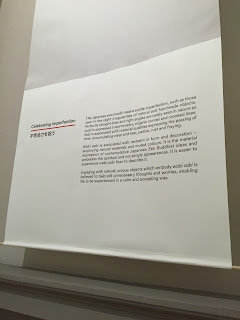Show me the Money Exhibition
There was an exhibition on in Manchester Art Gallery showcasing some contemporary Japanese designs. There was a theme running through the exhibition of clean cut sculpture as well as minimal colour. Most of the pieces were either predominately white, black or red. This made me think that perhaps instead of going for a more traditional outlook (which most bank notes currently use) that I should play around with more contemporary designs.
A lot of the pieces provided different textures which suggested that they don't only look beautiful, they have a unique feel to them when you touch them. Perhaps I could play with embossing or debossing paper to create interesting textures to feel on the paper bank notes to add a more sensory response.
I loved all of the designs and how they pushed the forms of objects to create beautiful shapes and silhouettes. Also what I found really interesting was that on the banners on the walls throughout the exhibition was information about the Japanese culture and it's art.
After deciding to do the Japanese Yen I took a look at their current bank note designs. The bank notes today are quite traditional like most bank notes today. The predominate colours used in the notes are greens, blues and reds. It looks like halftones have been used to mix colours and simplify the imagery. It also seems that the main notes for the yen are the 1000Y, 5000Y and 10000Y.
The one thing that I feel I might struggle with this brief is the fact that the text will be in Kanji, the Japanese characters. This will massively effect the typography choices that I can make but I think it will provide a good challenge for me. So I started to try and research about the notes themselves rather than the designs.
The Bills
The Japanese bank notes have the face of a renowned Japanese figure on the front, along with the amount written in kanji and numerically. 1,000 yen or “sen-en,” 5,000 yen or “go-sen-en” and 10,000 or “ichiman-en.” There is a shiny seal on the bottom left front of the 5,000 and 10,000 yen bills (the 1,000 yen not doesn’t have it). The oval in the center of the notes possess a watermark. When you hold the bill up to the light, you can see the same face of the historical figure that’s on the front of the bill.
As far as bills go, there is a 1000-yen bill, a 5000-yen bill, and 10,000-yen bill. There was a 2,000-yen bill and perhaps you can get them from a bank, but I’m not sure. It’s much like the $2 bill in the United States, few people have them but you may still be able to get them from your bank. So who’s on the front of these bills. Currently, Noguchi Hideyo (family name is listed first) is on the 1000-yen bank note. In the U.S., our banknotes have pictures of presidents on the obverse sides of the bills. In this case, Noguchi wasn’t a politician, but a prominent, Japanese bacteriologist. Pretty neat, huh?
Who’s on the 5000-yen note?
Currently, Higuchi Ichiyo (again family name first) is on the 5000-yen bank note. Higuchi was renowned for her writing and poetry during the late 1800s. Although Ichiyo is the name that appears on the bank note itself, “Ichiyo” was actually a pen name that Higuchi Natsuko used for her writing.
Who’s on the 10,000-yen note?
Fukuzawa Yukichi is on the 10,000-yen bank note. No, Fukuzawa wasn’t a Japanese politician either. Yukichi was a number of things, a writer, a translator, and a businessman, among other things. However his most well-known accomplishment was the founding on Keio University, which is located in Tokyo.
Kanji:
10,000 Yen = 一万円 (ichi man en)
1,000 Yen = 千円 (sen en)
2,000 Yen = 二千円 (ni sen en)
5,000 Yen = 五千円 (go sen en)
References used:
http://thejapanesepage.com/culture/japanese_moneyhttp://www.thejapanguy.com/the-japanese-yen/







































_front.jpg)

No comments:
Post a Comment